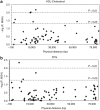Association of genetic variation in ENPP1 with obesity-related phenotypes
- PMID: 18464750
- PMCID: PMC4889449
- DOI: 10.1038/oby.2008.262
Association of genetic variation in ENPP1 with obesity-related phenotypes
Abstract
Ectonucleotide pyrophosphatase phosphodiesterase (ENPP1) is a positional candidate gene at chromosome 6q23 where we previously detected strong linkage with fasting-specific plasma insulin and obesity in Mexican Americans from the San Antonio Family Diabetes Study (SAFDS). We genotyped 106 single-nucleotide polymorphisms (SNPs) within ENPP1 in all 439 subjects from the linkage study, and measured association with obesity and metabolic syndrome (MS)-related traits. Of 72 polymorphic SNPs, 24 were associated, using an additive model, with at least one of eight key metabolic traits. Three traits were associated with at least four SNPs. They were high-density lipoprotein cholesterol (HDL-C), leptin, and fasting plasma glucose (FPG). HDL-C was associated with seven SNPs, of which the two most significant P values were 0.0068 and 0.0096. All SNPs and SNP combinations were analyzed for functional contribution to the traits using the Bayesian quantitative-trait nucleotide (BQTN) approach. With this SNP-prioritization analysis, HDL-C was the most strongly associated trait in a four-SNP model (P=0.00008). After accounting for multiple testing, we conclude that ENPP1 is not a major contributor to our previous linkage peak with MS-related traits in Mexican Americans. However, these results indicate that ENPP1 is a genetic determinant of these traits in this population, and are consistent with multiple positive association findings in independent studies in diverse human populations.
Conflict of interest statement
Figures



Similar articles
-
The ENPP1 K121Q polymorphism is associated with type 2 diabetes and related metabolic phenotypes in a Taiwanese population.Mol Cell Endocrinol. 2016 Sep 15;433:20-5. doi: 10.1016/j.mce.2016.05.020. Epub 2016 May 26. Mol Cell Endocrinol. 2016. PMID: 27238374
-
Haplotype structure of the ENPP1 Gene and Nominal Association of the K121Q missense single nucleotide polymorphism with glycemic traits in the Framingham Heart Study.Diabetes. 2008 Jul;57(7):1971-7. doi: 10.2337/db08-0266. Epub 2008 Apr 21. Diabetes. 2008. PMID: 18426862 Free PMC article.
-
Association of the distal region of the ectonucleotide pyrophosphatase/phosphodiesterase 1 gene with type 2 diabetes in an African-American population enriched for nephropathy.Diabetes. 2008 Apr;57(4):1057-62. doi: 10.2337/db07-0886. Epub 2008 Jan 9. Diabetes. 2008. PMID: 18184924
-
ENPP1 gene, insulin resistance and related clinical outcomes.Curr Opin Clin Nutr Metab Care. 2007 Jul;10(4):403-9. doi: 10.1097/MCO.0b013e3281e386c9. Curr Opin Clin Nutr Metab Care. 2007. PMID: 17563456 Review.
-
The role of ecto-nucleotide pyrophosphatase/phosphodiesterase 1 in diabetic nephropathy.Arq Bras Endocrinol Metabol. 2011 Dec;55(9):677-85. doi: 10.1590/s0004-27302011000900002. Arq Bras Endocrinol Metabol. 2011. PMID: 22231969 Review.
Cited by
-
Molecular basis of obesity: current status and future prospects.Curr Genomics. 2011 May;12(3):154-68. doi: 10.2174/138920211795677921. Curr Genomics. 2011. PMID: 22043164 Free PMC article.
-
Epitranscriptomic regulation of lipid oxidation and liver fibrosis via ENPP1 mRNA m6A modification.Cell Mol Life Sci. 2024 Sep 9;81(1):387. doi: 10.1007/s00018-024-05420-y. Cell Mol Life Sci. 2024. PMID: 39249529 Free PMC article.
-
Possible role for ENPP1 polymorphism in obesity but not for INSIG2 and PLIN variants.Endocrine. 2009 Aug;36(1):103-9. doi: 10.1007/s12020-009-9194-y. Epub 2009 Apr 28. Endocrine. 2009. PMID: 19399648
-
Identification of a putative protein profile associated with tamoxifen therapy resistance in breast cancer.Mol Cell Proteomics. 2009 Jun;8(6):1278-94. doi: 10.1074/mcp.M800493-MCP200. Epub 2009 Mar 27. Mol Cell Proteomics. 2009. PMID: 19329653 Free PMC article.
-
Inherited destiny? Genetics and gestational diabetes mellitus.Genome Med. 2011 Mar 25;3(3):18. doi: 10.1186/gm232. Genome Med. 2011. PMID: 21457499 Free PMC article.
References
-
- Meyre D, Lecoeur C, Delplanque J, et al. A genome-wide scan for childhood obesity-associated traits in French families shows significant linkage on chromosome 6q22.31-q23. 2 Diabetes. 2004;53:803–811. - PubMed
Publication types
MeSH terms
Substances
Grants and funding
LinkOut - more resources
Full Text Sources
Medical
Miscellaneous

